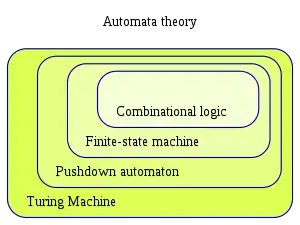Combinational logic
In automata theory, combinational logic (sometimes also referred to as time-independent logic[1]) is a type of digital logic which is implemented by Boolean circuits, where the output is a pure function of the present input only. This is in contrast to sequential logic, in which the output depends not only on the present input but also on the history of the input. In other words, sequential logic has memory while combinational logic does not.

Combinational logic is used in computer circuits to perform Boolean algebra on input signals and on stored data. Practical computer circuits normally contain a mixture of combinational and sequential logic. For example, the part of an arithmetic logic unit, or ALU, that does mathematical calculations is constructed using combinational logic. Other circuits used in computers, such as half adders, full adders, half subtractors, full subtractors, multiplexers, demultiplexers, encoders and decoders are also made by using combinational logic.
Practical design of combinational logic systems may require consideration of the finite time required for practical logical elements to react to changes in their inputs. Where an output is the result of the combination of several different paths with differing numbers of switching elements, the output may momentarily change state before settling at the final state, as the changes propagate along different paths. [2]
An alternate term is combinatorial logic. [3]
Representation
Combinational logic is used to build circuits that produce specified outputs from certain inputs. The construction of combinational logic is generally done using one of two methods: a sum of products, or a product of sums. Consider the following truth table :
| A | B | C | Result | Logical equivalent |
|---|---|---|---|---|
| F | F | F | F | |
| F | F | T | F | |
| F | T | F | F | |
| F | T | T | F | |
| T | F | F | T | |
| T | F | T | F | |
| T | T | F | F | |
| T | T | T | T |
Using sum of products, all logical statements which yield true results are summed, giving the result:
Using Boolean algebra, the result simplifies to the following equivalent of the truth table:
Logic formula minimization
Minimization (simplification) of combinational logic formulas is done using the following rules based on the laws of Boolean algebra:
With the use of minimization (sometimes called logic optimization), a simplified logical function or circuit may be arrived upon, and the logic combinational circuit becomes smaller, and easier to analyse, use, or build.
See also
References
- C.J. Savant, Jr.; Martin Roden; Gordon Carpenter. "Electronic Design: Circuits and Systems". 1991. ISBN 0-8053-0285-9 p. 682
- Douglas Lewin, Logical Design of Switching Circuits, Second Edition, Thomas Nelson and Sons, 1974, ISBN 017 771044 6, pp.162-163
- Clive Maxfield. "FPGAs: World Class Designs". p. 70. 2009. ISBN 1856176215
- Michael Predko and Myke Predko, Digital electronics demystified, McGraw-Hill, 2004. ISBN 0-07-144141-7
